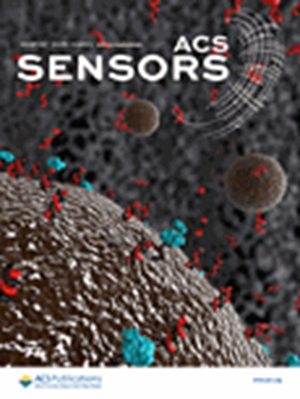基于碳纳米材料和分子印迹聚合物的光热纸微流控分析装置用于全氟辛烷磺酸的敏感定量。
IF 9.1
1区 化学
Q1 CHEMISTRY, ANALYTICAL
引用次数: 0
摘要
全球普遍存在的全氟烷基和多氟烷基物质(PFAS)污染突出表明需要敏感、可获得、简单和具有成本效益的分析工具。在本文中,我们提出了第一个基于光热的微流体纸基分析装置(PT-μPAD),用于检测各种基质(包括水,食物和人体样品)中最广泛存在的全氟辛烷磺酸(PFOS)。该器件将分子印迹聚合物(MIP)与碳点(CDs)集成,通过测量μPAD传感器上的温度变化,实现了对全氟辛烷磺酸的选择性和灵敏度监测。此外,检测信号通过嵌入便携式用户友好平台的无线近场通信(NFC)系统快速获得。优化后,所开发的传感器提供1.5至7.0 pg mL-1的线性范围(R2 = 0.9989),检测限(检测限(LOD))为7.0 fg mL-1。我们开发的传感器还具有高选择性,没有观察到的干扰效应。该方法对实际样品的全氟辛烷磺酸定量具有良好的准确度和精密度,回收率为92.5 ~ 110.0%,相对标准偏差(RSD)最高为7.3%。相应的,我们的方法得到的结果与高效液相色谱-质谱(HPLC-MS/MS)方法相当,在t检验分析中有95%的置信度。因此,该传感器非常适合各种样品矩阵的全氟辛烷磺酸监测,具有简单,成本效益,便携性和非熟练操作员易于使用等关键优势。总的来说,这种方法可以通过MIP修饰扩展到其他靶分子的检测,显示出它的通用性。此外,这一概念具有更广泛应用的巨大潜力,包括医疗现场诊断和预后、现场环境分析和食品安全。本文章由计算机程序翻译,如有差异,请以英文原文为准。
Photothermal Paper-Based Microfluidic Analytical Device Integrated with Carbon Nanomaterials and Molecularly Imprinted Polymers for Sensitive Perfluorooctanesulfonate Quantification.
The global prevalence of perfluoroalkyl and polyfluoroalkyl substance (PFAS) contamination highlights the need for sensitive, accessible, simple, and cost-effective analytical tools. In this article, we present the first photothermal-based microfluidic paper-based analytical device (PT-μPAD) for the detection of perfluorooctanesulfonate (PFOS), one of the most widespread PFAS, in various matrices, including water, food, and human samples. By integration of a molecularly imprinted polymer (MIP) with carbon dots (CDs), the device achieves selective and sensitive PFOS monitoring by measuring the temperature change on the μPAD sensor. Additionally, the detection signal is rapidly obtained via a wireless near-field communication (NFC) system embedded in a portable and user-friendly platform. Under optimization, the developed sensor delivers a linear range between 1.5 and 7.0 pg mL-1 (R2 = 0.9989) and a detection limit (limit of detection (LOD)) of 7.0 fg mL-1. Our developed sensor also exhibits high selectivity, with no observed interferent effects. The method also demonstrates remarkable accuracy and precision for PFOS quantification across real-world samples, achieving recovery percentages of 92.5-110.0% and the highest relative standard deviation (RSD) of 7.3%. Correspondingly, the results obtained using our method are comparable to those from the high-performance liquid chromatography-mass spectrometry (HPLC-MS/MS) method, as confirmed by a 95% confidence level in the t test analysis. Therefore, this sensor is well-suited for PFOS monitoring across various sample matrices, offering key advantages, such as simplicity, cost-effectiveness, portability, and ease of use by unskilled operators. Overall, this approach can be extended to the detection of other target molecules through MIP modification, showing its versatility. Furthermore, this concept holds great potential for broader applications, including medical point-of-care (POC) diagnostics and prognostics, on-site environmental analysis, and food safety.
求助全文
通过发布文献求助,成功后即可免费获取论文全文。
去求助
来源期刊

ACS Sensors
Chemical Engineering-Bioengineering
CiteScore
14.50
自引率
3.40%
发文量
372
期刊介绍:
ACS Sensors is a peer-reviewed research journal that focuses on the dissemination of new and original knowledge in the field of sensor science, particularly those that selectively sense chemical or biological species or processes. The journal covers a broad range of topics, including but not limited to biosensors, chemical sensors, gas sensors, intracellular sensors, single molecule sensors, cell chips, and microfluidic devices. It aims to publish articles that address conceptual advances in sensing technology applicable to various types of analytes or application papers that report on the use of existing sensing concepts in new ways or for new analytes.
 求助内容:
求助内容: 应助结果提醒方式:
应助结果提醒方式:


